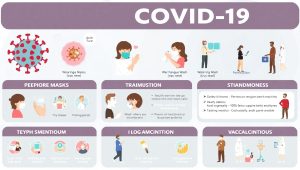
COVID-19, caused by the novel coronavirus SARS-CoV-2, has had a profound impact on the world since its emergence in late 2019. Understanding the virus, how it spreads, and the steps to protect yourself and others is crucial in managing its effects and reducing its transmission.
What is COVID-19?
COVID-19 is an infectious disease that primarily affects the respiratory system. The virus spreads mainly through respiratory droplets when an infected person coughs, sneezes, or talks. It can also spread by touching contaminated surfaces and then touching your face. Symptoms range from mild to severe and may include fever, cough, difficulty breathing, fatigue, and loss of taste or smell. In severe cases, it can lead to complications such as pneumonia or organ failure.
How Does It Spread?
COVID-19 is highly contagious and spreads in several ways:
- Close Contact: Being near an infected person increases the risk of transmission.
- Airborne Particles: In enclosed spaces, small particles can linger in the air, especially without proper ventilation.
- Surface Contact: While less common, touching a surface with the virus and then touching your face can lead to infection.
Who is at Risk?
Certain groups are at a higher risk of severe illness from COVID-19, including older adults, individuals with underlying health conditions like diabetes or heart disease, and those with weakened immune systems. However, anyone can contract and spread the virus, making universal precautions essential.
How to Protect Yourself and Others
Taking preventive measures is critical in stopping the spread of COVID-19. Here are some key steps:
- Get Vaccinated: Vaccines are highly effective in reducing severe illness and hospitalization. Stay up-to-date with booster doses as recommended by health authorities.
- Wear Masks: Use well-fitted masks, especially in crowded or indoor settings. Masks help block respiratory droplets and reduce transmission.
- Practice Hygiene: Wash your hands regularly with soap and water or use hand sanitizer with at least 60% alcohol.
- Maintain Distance: Stay at least six feet away from others, especially if they show symptoms of illness.
- Improve Ventilation: Ensure good airflow in indoor spaces to reduce the concentration of airborne particles.
Testing and Isolation
If you experience symptoms or have been exposed to someone with COVID-19, get tested promptly. Testing helps identify cases early and prevents further spread. If you test positive, isolate yourself to protect others and follow guidelines provided by healthcare professionals.
Long-Term Effects
Some individuals experience long-term symptoms even after recovering from COVID-19, a condition commonly referred to as “long COVID.” These symptoms can include fatigue, difficulty concentrating, and respiratory issues. Awareness and early medical intervention can help manage these effects.
The Role of Community
Combating COVID-19 requires collective effort. Communities play a vital role in promoting awareness, distributing vaccines, and supporting those affected. By working together, we can reduce the impact of the virus and protect vulnerable populations.
Conclusion
Learning about COVID-19 empowers individuals to make informed decisions about their health and safety. By staying informed, practicing preventive measures, and supporting community efforts, we can navigate the challenges posed by this pandemic and move towards a healthier future. Together, we can reduce the virus’s impact and safeguard public health.
Hi, this is a comment.
To get started with moderating, editing, and deleting comments, please visit the Comments screen in the dashboard.
Commenter avatars come from Gravatar.